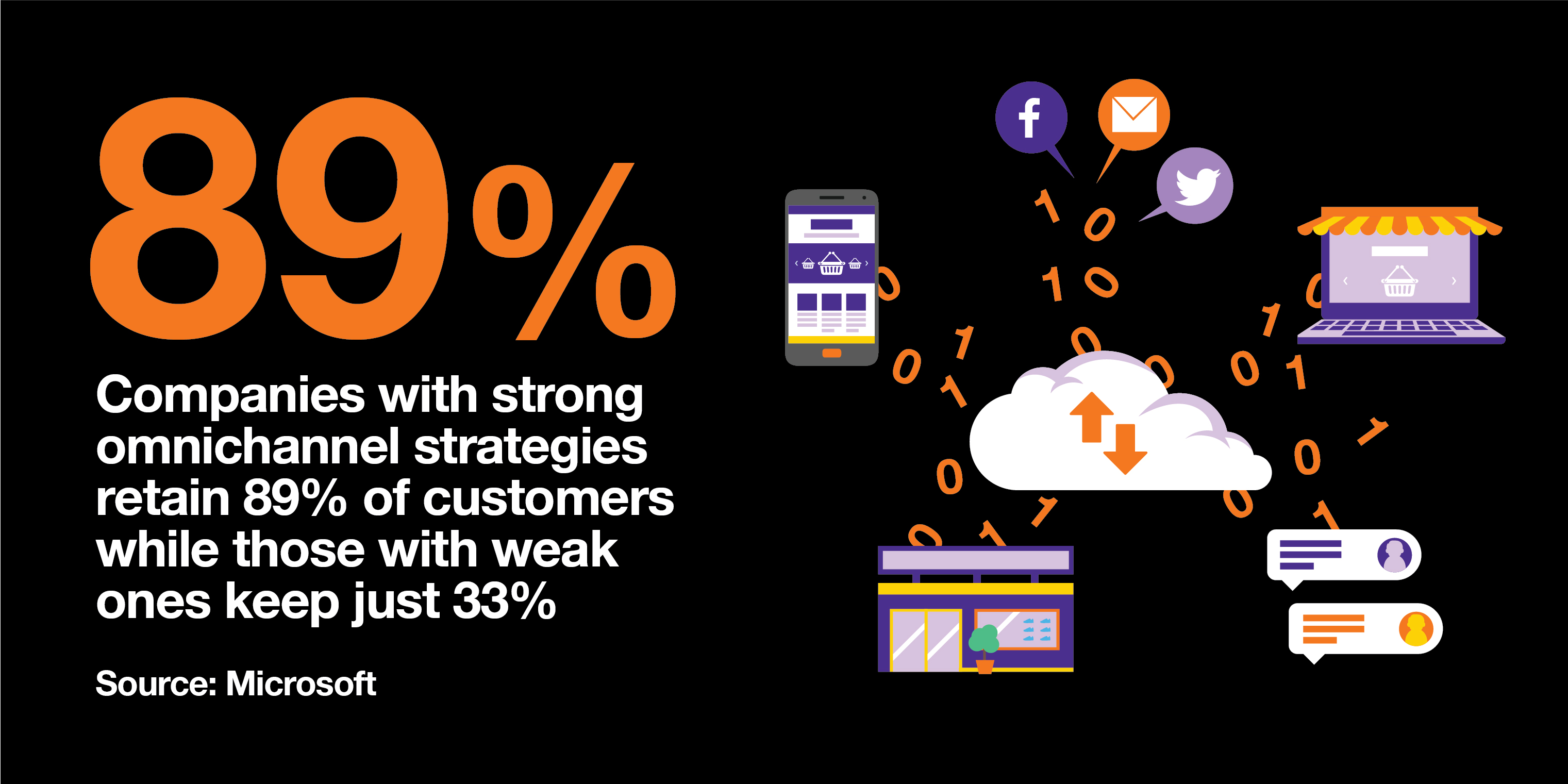In his 2018 annual statement to shareholders, Amazon CEO Jeff Bezos said: “One thing I love about customers is that their expectations are never static – they go up. It’s human nature. People have a voracious appetite for a better way, and yesterday’s ‘wow’ quickly becomes today’s ‘ordinary.’ I see that cycle of improvement happening at a faster rate than ever before.”
Retail, by its very nature, is customer centric, and customers can be very demanding. Today they expect an omnichannel and personalized experience.
Omnichannel means being able to give shoppers a seamless and consistent experience across all channels and via all the different devices they use to interact with you. With consumers now able to make purchasing decisions at any point on the customer journey, an omnichannel strategy is simply essential for every retailer. According to Aberdeen Group, companies with strong omnichannel customer engagement strategies retain an average of 89% of customers, whereas companies with weak omnichannel strategies retain only 33%.

Personalization is also essential to attract discerning customers. Progressive retailers should use customer-centric data forensically to create and deliver a hyper-personalized customer experience. According to Frost & Sullivan, customer experience will overtake price and product as the key brand differentiator by 2020. Data is the key to unlocking new levels of understanding of consumer behavior.
Because of the drive to omnichannel and personalization, there are many new digitally-native, niche brands entering the market. They often target millennial consumers who already spend $600 billion per year in the U.S. A study by Retail Dive found that digitally-native brands plan to open over 850 stores in the U.S. in the next five years, while in contrast, traditional brick-and-mortar retailers closed approximately 7,000 stores in 2018.
All about the experience
“Putting the customer first” has always been a retail mantra, but that has been difficult for global retailers to do at scale. Monitoring social media for customer sentiment is not enough. Retailers need to adopt customer-centric models that empower them to determine what customers want and how to deliver it – in real time and at scale.
According to Salesforce’s 2019 retail predictions: “Data will be the currency of the retail renaissance. Customer data, and integration of that data across enterprise systems and touchpoints, will be a strategic imperative in 2019 as retailers accelerate their journey toward customer centricity.” Retail is about much more than just product and price; Gartner believes that for 2019 and beyond, 81% of retailers expect to be competing mostly or completely on the basis of customer experience.
The digital approach retailers must embrace
Retailers must embrace new digital technologies to stay relevant in a fiercely competitive marketplace. Orange believes in taking a four-pronged approach to digitally transforming retail.
1. The digital store. Physical stores still drive between 80-90% of total retail sales in most markets, meaning retailers must make the in-store shopping experience enjoyable to attract and retain customers. The digital store needs to include high-speed Wi-Fi to collect shopper data and match demographics to locations and preferences, and more. It also needs to engage in-store shoppers with display ads on store portals to promote product discounts and additional services.
Digital tools can help retailers with queue management to reduce shopper dissatisfaction and optimize in-store experiences through the store’s layout using real-time customer knowledge of the customer journey and heatmaps. Network connectivity is vital, and retailers need to know whether they can enhance customer experience best with LoRa, LTE-M, 3G/4G, RFID, SD-WAN or a mix of several technologies.
2. Customer centricity. To give customers a superior omnichannel shopping experience, retailers need to optimize customer satisfaction and loyalty across all channels. This means giving customer service agents unified views of every customer across every contact channel, along with any customer insights from analytics. Chatbots can reduce the number of basic inquiries that human agents must deal with and free them to handle more complex tasks. Platform-as-a-service (PaaS) can simplify deployment of e-commerce platforms to keep enhancing end-user experiences.
3. The empowered workforce. Retail employees are no longer just customer service reps at the end of a phone line. In the digital era, they must become personal advisors, empowered with contact center data that they can turn into actionable insights and shared intelligence. They must enjoy a mobile workspace that lets them be more efficient and allows them to collaborate in real time. Retail companies must also commit to their employees by giving them a training journey that helps recruit, retain and develop the best talents, particularly among millennials.
4. Agile operations. Retailers need to use the latest digital technologies to enhance retail operations results and to increase growth. Digital retail requires a smart and scalable infrastructure that is aligned to business needs and incorporates application performance management. Flexible cloud solutions enable handling of the ever-increasing levels of data, network foundations built on SDN/NFV can enhance agility, and everything must be underpinned by state-of-the-art cybersecurity to ensure data integrity.
Retailers that focus on becoming digital from front-to-back will be those best equipped to thrive in the digital retail era and will keep customers coming back for another great experience.
Check out our solutions for the retail sector, including digital stores, omnichannel shopping, branch connectivity and employee engagement.